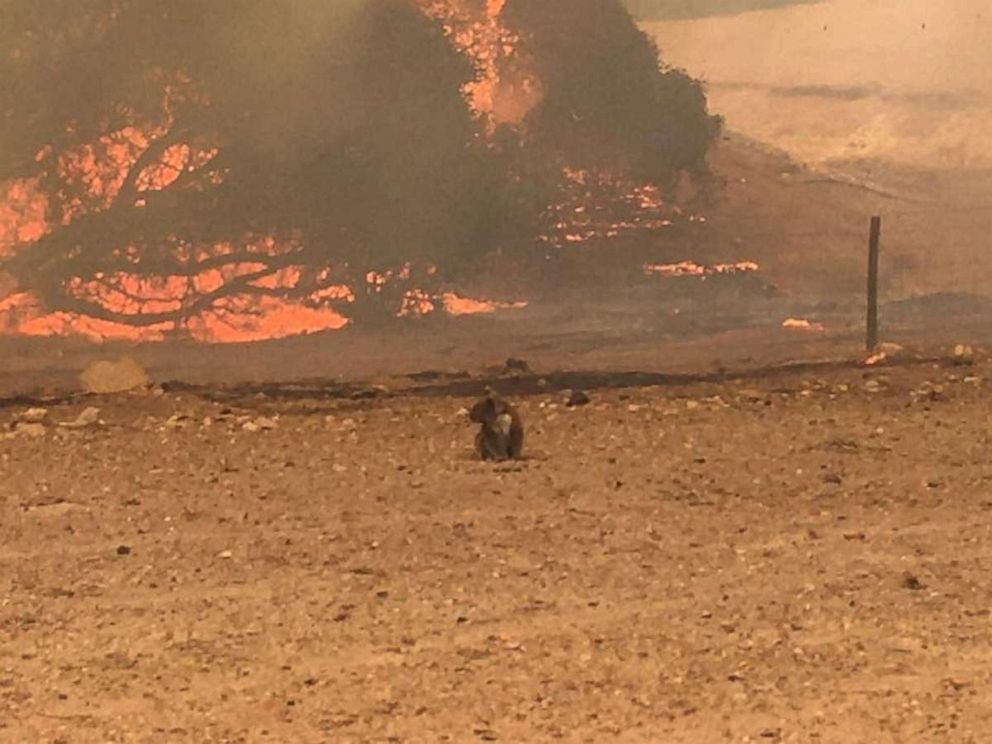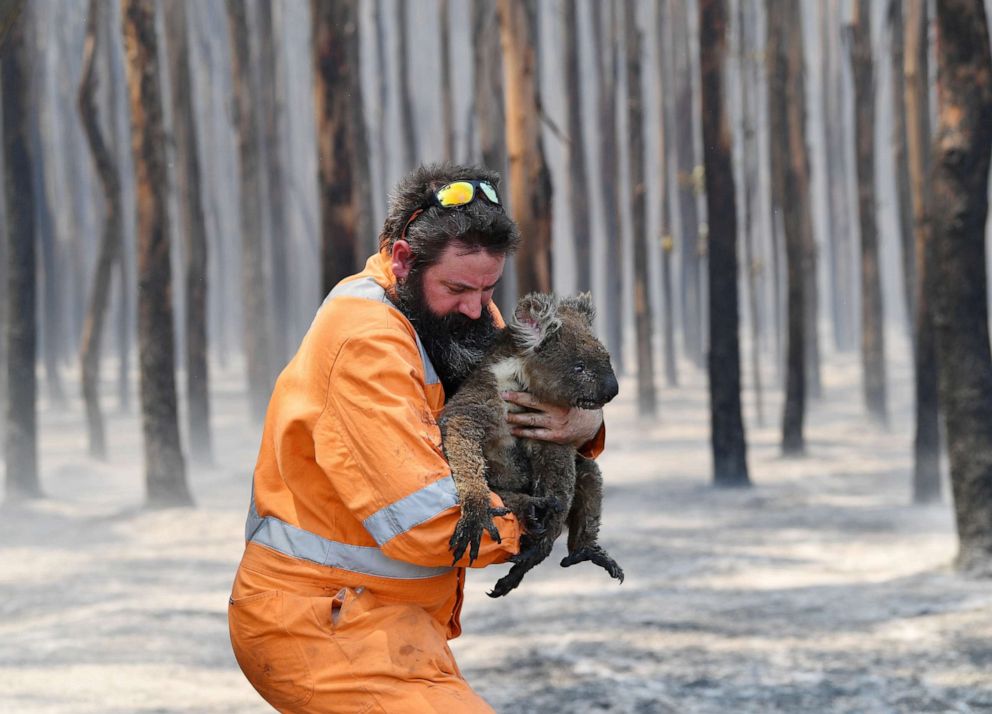A look at koalas in Australian culture amid the fires that are devastating their population
Australians fear that the fate of the koala may end in functional extinction
The estimated deaths of more than 25,000 koalas have left Australians fearful that the fate of the country's native animals may end in functional extinction.
Bushfires have transformed Australia’s scenic landscape to one ravaged by smoke, flames and ruin. The fires, which began in early-September, have claimed the lives of 25 people, destroyed more than 2,000 homes, and left an estimated 1 billion animals dead.
Sam Mitchell, co-owner of the Kangaroo Island Wildlife Park, told The Guardian that koala numbers had been around 50,000, but "probably more than half" would have died in the fires. He noted it was "a guessing game."
Fire seasons regularly take place in the country, but this year has been particularly devastating. The country experienced one of its hottest and driest years, in part, because of the Indian Ocean dipole (IOD), which is a variation in sea surface temperature on the Indian Ocean that drives the weather patterns. The IOD was in its strongest positive phase in more than 20 years, resulting in conditions that led to cooler sea surface temperatures near Australia and, in turn, less storm action and less rain action for the country.
With the fire season expected to rage on for the next few months, Australians are doubtful that wildlife will fully recover, and many have expressed concern for the slower moving koala population.

As a cultural symbol and international attraction, koalas have found homes in the hearts of many who travel from across the globe to see forests and natural parks where they reside.
“Koalas have been around for the same length of time as the first Australians - possibly longer,” Dr. Roslyn Irwin, President of Friends of the Koala, told ABC News. “They’ve been a strong feature in our landscape for a while now, and people really value that.”
Aboriginal culture, dating back 60,000 years ago when the first indigenous people arrived in Australia, depicts koalas in a number of myths and legends. The marsupial became symbolic to individual Clans and Nation groups who adopted it as a totem.
Koalas continue to be totems for people like the Ngarbal in the Glen Innes area of northern New South Wales, and for non-Indigenous Australians, the native animal is seen as a powerful symbol.
Deborah Tabart, fondly known as “the koala woman,” is Chairman of the Australian Koala Foundation, which aims to conserve and manage koalas in the wild. With over 30 years of experience, Tabart says she has been lucky in her years to be around Aboriginal people who have immense knowledge of the bush.
“Spiritually, koalas are important. An Aboriginal Elder once said to me ‘rivers grieve for the deaths of their children,'' Tabart said. "That’s exactly what we need to do. We have to grieve for what happened to this land. Then we need to do better.”
Numerous wildlife experts attribute drought and a lack of underground water to the cause and spread of the fires. Some cite river complexes managed by the government are poorly cared for, and water taken out for crops such as cotton have left towns barren. Because of prolonged droughts across Australia, rain forests, in addition to the bush, are burning, and koalas are dying of hunger and thirst.

"We have taken too much water out of our systems, cleared too much land for agriculture and housing, and river systems are running dry," Tabart said. "Lack of respect for water is what's plaguing us now. This fire is the phoenix that has to get more people to be protective of our land."
It isn’t the first time koala numbers have dwindled towards near extinction. Beginning in the 18th century, when Europeans settled in Australia, koalas were killed for their fur, which was shipped to London and North America.
Research conducted by the Australian Koala Foundation (AKF) found that around 8 million koalas perished as a result of the fur market, and it wasn’t until 1927 that the trade stopped.
In recent years, koala numbers have been on a decline once again, even before the start of this year's deadly bushfires. Populations tend to inhabit the eastern coast where humans live and have been devastated by the demands of residential, commercial, and industrial developments. Disease, deforestation, and dog attacks, of which koalas are frequent victims, have severely affected the group's chances of survival.
With bushfires running rampant, wildlife advocates are doubtful that the animals will ever regain their numbers. Now another set of concerns have gripped Australia's community and spread to the international one as well.

The country is dependent on the koala as an incentive for travel and tourism, one of its largest industries. A recent study by The Australian Koala Foundation, The Economic Value of the Koala, found that koalas create over 30,000 jobs in the tourism industry.
“Australia will be losing millions of dollars,” Tabart said. “Koalas bring in 3.2 billion per year from tourists hoping to see some. They are huge economic generators.”
Australian attractions are largely related to the beautiful landscape and diverse wildlife in national parks and forests, but these features in areas across the country such as Victoria and New South Wales have fallen victim to large portions of the damage. Blazes have left native, mature trees badly burnt and in need of felling.
With hundreds of communities facing the effects of burnt homes and businesses, Irwin similarly says it is unlikely that tourists will come anytime soon.
“People who want to enjoy the land and animals like koalas will have to think again until the fires stop. The smoke is so bad, ash from the forest is reaching parts of New Zealand, and no one wants to come here and wear a mask.”
The economic impact on Australia is expected to be substantial, with the effects hard-hitting in smaller towns. The fall of tourism is feared to bring about another unwanted effect – forestry. Though logging presents a way to generate jobs and rebuild homes, the practice is not sustainable and contributes to biodiversity loss.
With the fires expected to continue in upcoming months, wildlife advocates question whether full recovery is obtainable. Substantial global donations have been made in efforts to tame the firestorms and cover losses, yet doubt remains.
“This country is going to find it incredibly difficult to recover and plans will take a long time to develop,” Irwin says. “We have been overwhelmed at the generosity of the world – there are funds, but protections need to be put in place and legislation passed that prevents habitats from being destroyed. Right now it’s too early tell. We just don’t know the extent and what the likelihood of recovery is.”
ABC News' Ginger Zee contributed to this report.



